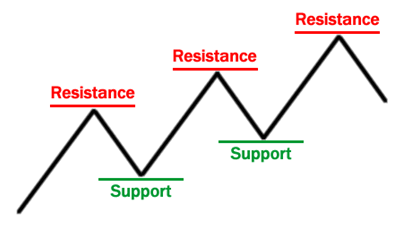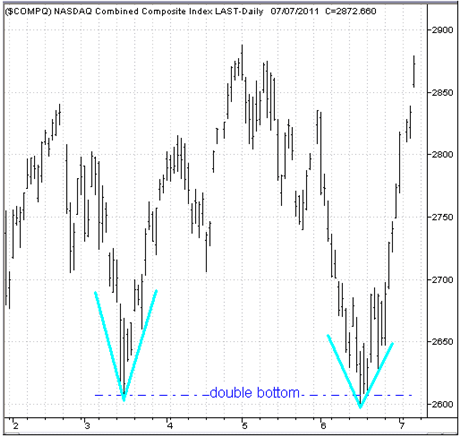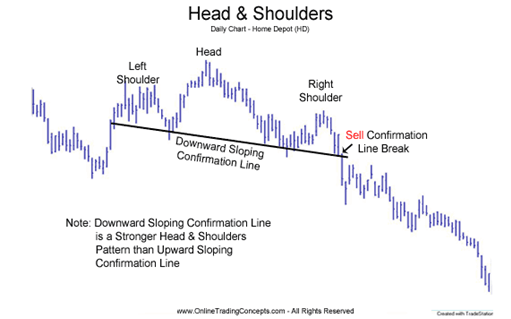Charts have proved to be highly valuable and easiest form of tools in the technical analysis. As the data related to prices of shares are graphically represented in the charts, investors find it easier to extract information related to current trend in price movements, possible future movements in the prices, identification of support and resistance level of prices etc. The common type of trends and information that could be inferred by reading the charts include Support and resistance level of prices V formation Tops and bottoms Heads and shoulders Triangles Flags and pennants Support and Resistance level of prices Support level is referred to the point at which the share prices would be prevented from further decline by increasing demand for the shares in the market. Thus the fall in prices would either be halted for a short span of time or the shares would move towards a trend reversal from bearish phase to bullish phase. On the other hand, when the share prices reach the resistance level, their upward movement would further be prevented by falling demand for the shares. This could also happen due to greater supply in the shares, as a result of which the share prices would fall. Say for example, if the price of a share keeps moving around $65 for weeks, then it would rise and reach a level of $80 after which the share prices would fall down and reach the original level of $65. Then the level of $80 would be referred to as the resistance level for the share, after which the share prices are not allowed to increase. On the other hand, the prices would not be allowed to decrease below the level of $65, which is the support level. Thus, at the resistance level, the supply of shares would be higher and at the support level, the demand for shares would increase.  V Formation As the name indicates, the V formation indicates sharp increase or decline in share prices followed by a fast trend reversal. The V- formation mostly occurs in popular stocks where the market interest changes quickly. On the other hand, in case of inverted V formation, the increase in share prices occurs followed by a trend reversal with decline in prices. There are extended V formations in which the bottom or top of the V would extend for longer periods of time over broader areas. Tops and bottoms Top and bottom formations in share prices, though interesting to watch, prove to be more important with respect to its middle portion. The investor has to buy after the beginning of an up trend and exit before the asset reaches a top. Generally, tops and bottoms are formed at the beginning or end of the new trends. The reversal from the tops and bottoms indicate sell and buy signals.  Double tops and bottoms This type of formations signals that one trend would end and another trend is about to begin. If the double top is formed when the security price rises to a certain maximum level, then drops rapidly to the bottom, further increases to the same peak level before falling down. Its pattern resembles the letter M. However, the results obtained from such tops and bottoms should be confirmed with the information related to volume and trend. Head and Shoulders This is a very common pattern observed in the charts and is very easy to identify and highly reliable. In this pattern, there are three rallies to be observed namely one left shoulder, one head and one right shoulder. The lowest point in the tops is then connected to form a neck line and is further extended. When the share prices cut the neck line and then move upwards, it would indicate trend reversals of the share moving from bearish to bullish phase. For the inverted head and shoulders pattern, the reverse of the patterns formed above would hold true.  Triangles The triangle formation including different categories like ascending, descending and symmetrical triangles are very popular in technical analysis. Symmetrical triangle is formed with series of fluctuations in share prices with tops, which are lower than the previous ones, and bottoms, which are higher than previous ones. While the symmetrical triangle does not give information on bullish or bearish phase of the shares, it just indicates a halt in the movement of share prices. Flags The flag patterns commonly emerge when there is a fall or rise in the share. The flag patterns commonly would indicate corrections of the oversold or overbought zones in share prices. Though the time to form these flag patterns is very short, the price rally or decline would take three to four days to continue. The maximum time taken to complete one flag pattern would be three weeks. Pennants Pennants are much more similar to the symmetrical triangles. When the pennant is bullish in trend, then the lower tops would form the upper trend line. On the other hand, the bearish trend occurs when the value of scrip moves above the upward trend line. Also in the bearish trend, fall in upper trend line and rise in lower trend line could be observed. Charts thus prove to be major tools for technical analysis, which give highly relevant information for investors to determine their buy and sell strategies in the capital markets. comments powered by Disqus |

|
|
|
|







